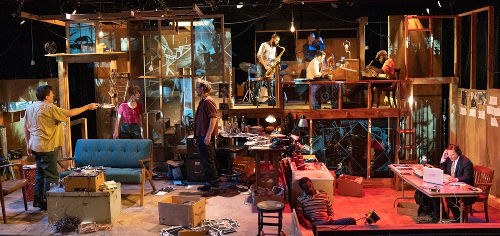
Glenda
Frank
And All that Jazz!
Inspired by events at 821 6th Ave, in a rundown tenement in the Flower District, “(A)loft Modulation” by Jaymes Jorsling, produced by american vicarious at A.R.T., is about the obsession of men addicted to what they call POP, the pursuit of perfection. The 1950s to early 1960s were times of conformity and rigid codes -- except among one group of trailblazers: the artists, who ushered in the revolutions of the 1960s and 1970s. The names are familiar to us: Beats Allen Ginsberg and Jack Kerouac, jazz innovators Miles Davis and Thelonious Monk, painters Robert Rauschenberg and Cy Twombly, choreographer Merce Cunningham, and in photography the brilliant W. Eugene Smith. “(A)loft Modulation” is a flawed play in a flawed production but it brings that period of time back to vivid life. It’s as though we were a fly on the wall. The slice of life play is not for everyone, but for those of us with a deep affection for Smith and the period, the play is catnip. Set designer Troy Hourie was inspired. He divided the stage into
three sections. Each is chaotic, overfilled with props (design by
Leila Ben-Abdallah) that define the characters and the action. The
upstairs loft houses a jazz ensemble, led by Way Tonniver (Eric
T. Miller), a character inspired by Hall Overton, a teacher of classical
theory and composition at The Julliard School of Music. At night,
after his respectable day job, he was a jazz band leader, immersed
in the grungy life of 50s musicians. Next door is an office where Steve Samuels (Kevin Cristaldi), 60 years later, listens to the unlabeled tapes, trying to sort them. To his wife’s (Julia Watt) dismay, he quit his job to devote himself to the task full time. We hear some of the archival tapes, notably Smith’s rants against his mother and “Life Magazine,” which offered him some of his best assignments but did not always appreciate his photo essays. The character of Samuels was inspired by Sam Stephenson, who spent 13 years researching Smith’s life and the loft. He is currently the director of the Jazz Loft Project at Duke University's Center for Documentary Studies. His research was the basis for “The Jazz Loft Project,” his book, an NPR radio series, and a traveling exhibition, which opened in 2010 at the New York Public Library for the Performing Arts. In addition to the archival material, the play features piano composition by Grammy Award nominee Gerald Clayton and a live improvisational jazz band led by saxophonist Jonathan Beshay with Kayvon Gordon on drums and Adam Olszewski on bass. The building is alive with action, which is part of the problem. “(A)loft Modulation” is not always easy to follow as it jumps from story to story, or even scene to disconnected scene. Director Christopher McElroen allowed so much stage action, it was exhausting. Reggie Sweets (good performance by Elisha Lawson), a talented jazz saxophonist, runs the gamet from doped stupor to brilliance. He is the tragic center. He epitomizes what Ginsberg wrote in “Howl”: “I saw the best mind of my generation destroyed by madness, starving hysterical naked, ... angelheaded hipsters burning for the ancient heavenly connection to the starry dynamo in the machinery of night.” But he is continually up and down the stairs, a distraction when the scene has nothing to do with him, a movement that undercuts the poignancy. Beside the authentic atmosphere of artists interacting and working, the joy of “(A)loft Modulations” is its rare depiction of Smith – warts and all, with no explanation or apology. When the play ends he has installed a front door with a lock and is on his way to create his masterpiece, a photo essay on mercury poisoning in Minamata, Japan. Those pictures haunt me. Damaged children and the mothers devoted to their care. We have all seen more than our share of horror photographs, but Smith transform the images into works of art. Their hooks into the imagination – into our horror and pity -- are tenacious. The closest comparison is the work by Diane Arbus. Smith created 40,000 pictures of life in the loft between 1957-1965. The photographs are projected and, as if in a darkroom, hung by clothes pins across the stage (which are removed, hung, and removed). The first act is 90 minutes long, the second an hour after a 15 minute intermission.
|
| recordings | coupons | publications | classified |

